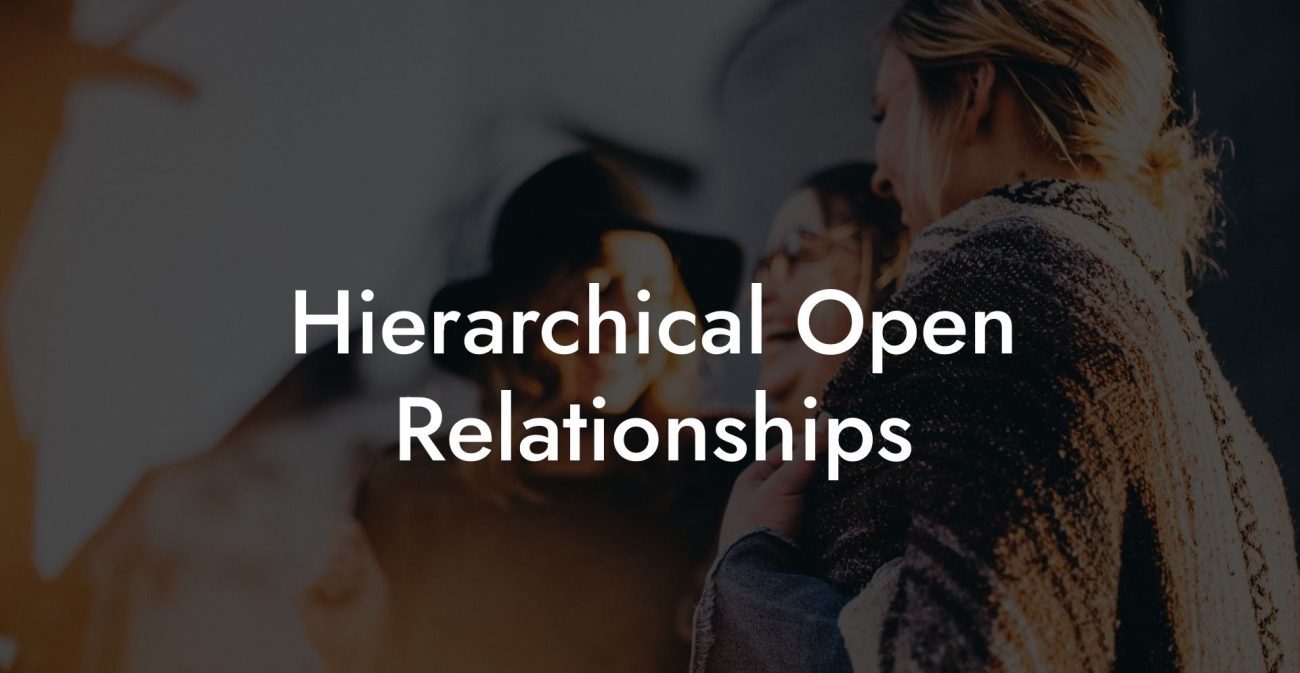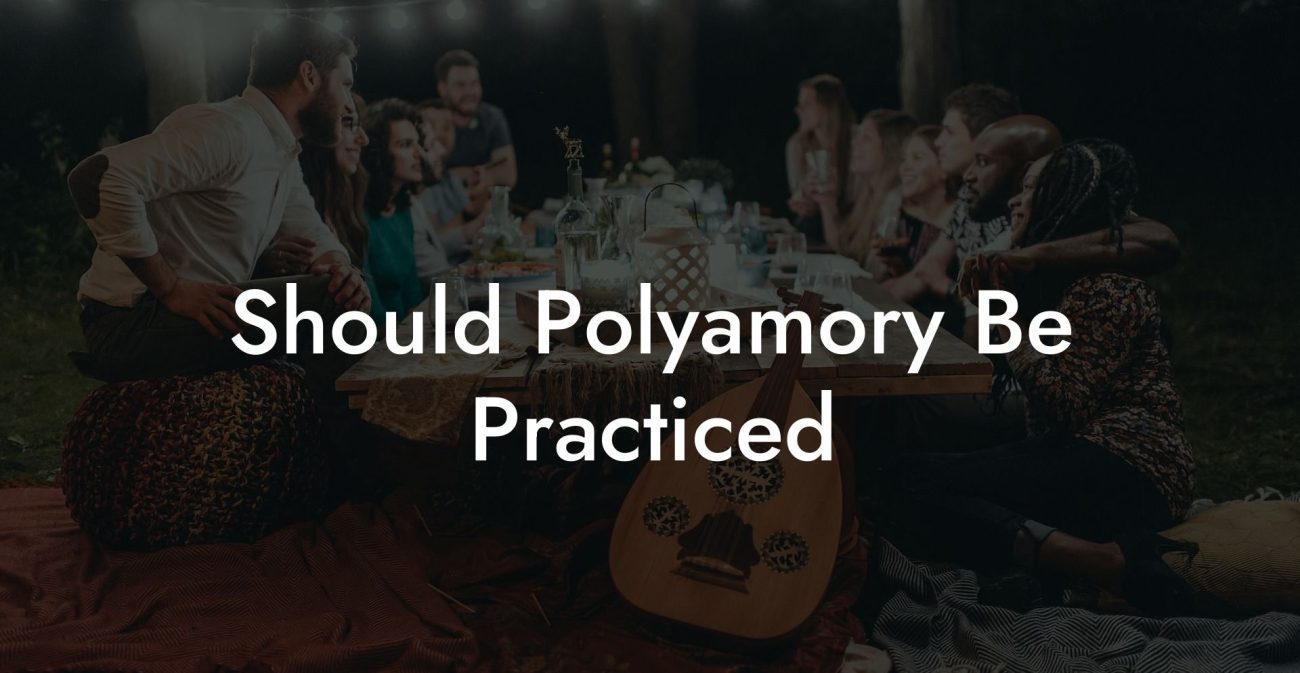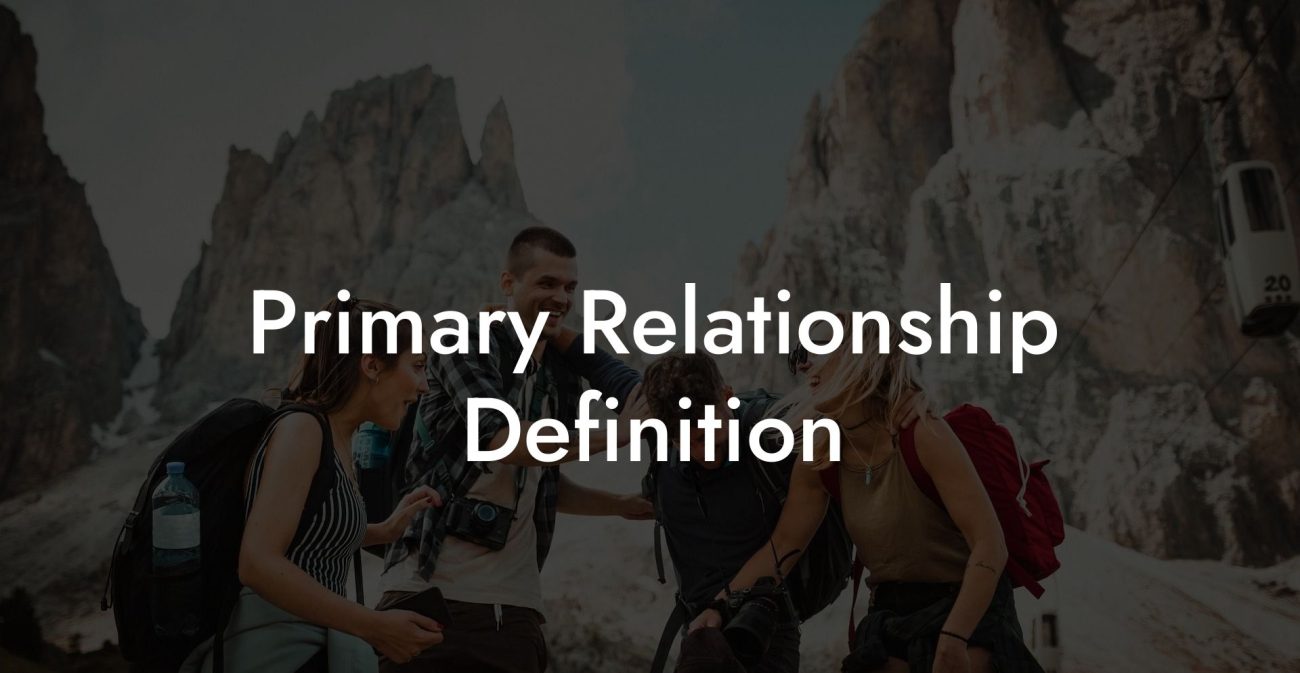Relationship Hierarchy

Picture a symphony in which every instrument plays a vital role—some lead with bold solos, while others provide a gentle harmony that supports the entire composition. In the world of relationships, a hierarchy can serve as the score that helps each connection find its proper place, whether in traditional monogamy or in more fluid, non-monogamous arrangements. Welcome to our comprehensive guide on Relationship Hierarchy, where we explore how structuring your connections—by prioritizing some bonds over others—can bring clarity, stability, and balance to your love life. Get ready to dive deep into definitions, historical contexts, benefits, challenges, and practical strategies for navigating a relationship hierarchy that works uniquely for you.
Have you ever wondered if monogamy is just a stupid little experiment? Open relationships, polyamory, relationship anarchy...find out which relationship dynamic suits you best with our one minute relationship test. See if you are just conforming to "societal norms". Reveal your truth >>
Quick Links to Useful Sections
- Understanding Relationship Hierarchy
- Defining Relationship Hierarchy
- Historical and Cultural Evolution
- From Implicit Norms to Conscious Choices
- Types of Relationship Hierarchy
- Hierarchical Models in Non-Monogamy
- Implicit Hierarchies in Traditional Monogamy
- Benefits of Relationship Hierarchy
- Clarity and Structure
- Enhanced Emotional Security
- Efficient Time and Resource Management
- Opportunities for Personal and Mutual Growth
- Challenges of Relationship Hierarchy
- Potential for Jealousy and Insecurity
- Managing Complex Dynamics
- Risk of Overemphasis on Hierarchy
- External Judgments and Social Stigma
- Strategies for Successfully Navigating Relationship Hierarchy
- Open and Ongoing Communication
- Clearly Define Roles and Boundaries
- Utilize Digital Tools for Coordination
- Invest in Self-Care and Personal Growth
- Build a Supportive Community
- Be Flexible and Open to Change
- Real-Life Success Stories
- Case Study: The Miller Family’s Harmonious Hierarchy
- Case Study: Riley, Jordan, and Casey’s Fluid Dynamic
- Expert Insights on Relationship Hierarchy
- FAQ: Your Relationship Hierarchy Questions Answered
Understanding Relationship Hierarchy
Defining Relationship Hierarchy
Relationship hierarchy refers to a system of organizing your interpersonal connections according to levels of importance, commitment, or priority. In many non-traditional relationships, such as polyamory, individuals often designate one partner as “primary” while considering others as secondary or tertiary. This hierarchy is designed not to devalue any connection but to clarify roles, set expectations, and help manage the practical aspects of emotional and time investment.
Even in traditional settings, the concept of hierarchy can be implicit—for instance, when one partner is the main emotional or financial anchor. In modern relationship dynamics, however, hierarchy is often a conscious decision made by all involved parties, ensuring that everyone is aware of their role and the expectations that come with it.
Historical and Cultural Evolution
From Implicit Norms to Conscious Choices
Historically, many societies operated under implicit hierarchical structures. In traditional monogamy, the notion of a “primary” relationship was built into the institution of marriage, where one partner was the main focus of emotional, financial, and familial commitment. However, as alternative relationship models emerged in the late 20th century—fueled by feminist movements, sexual liberation, and LGBTQ+ activism—the concept of relationship hierarchy was reexamined.
Today, in communities embracing ethical non-monogamy, relationship hierarchy is not imposed by tradition but negotiated openly among partners. Whether through a designated primary partner or a more fluid ranking system, modern relationship hierarchies are a product of deliberate choice, aiming to balance individual autonomy with the need for stability and intimacy.
Types of Relationship Hierarchy
Hierarchical Models in Non-Monogamy
In the realm of ethical non-monogamy, hierarchical models are commonly used to create structure:
- Primary-Secondary Structure: The most common model where one partner is considered the primary partner—receiving the majority of time, emotional energy, and shared responsibilities—while other partners are designated as secondary or tertiary, with a lower level of integration.
- Fluid Hierarchy: Some relationships maintain a flexible hierarchy that can shift over time based on evolving needs and circumstances. In this model, roles are not rigidly fixed; rather, they are renegotiated as all partners grow and change.
- No Hierarchy: For some, non-hierarchical relationships (also known as egalitarian polyamory) are ideal. Here, all partners are considered equal with no predetermined ranking. While this model minimizes power imbalances, it can present its own set of challenges in managing time and expectations.
Implicit Hierarchies in Traditional Monogamy
Even within traditional monogamous relationships, certain implicit hierarchies exist—such as the centrality of one partner in decision-making, financial management, or family life. These traditional roles can sometimes be taken for granted, yet recognizing them consciously allows couples to negotiate responsibilities and ensure that both partners feel valued.
Benefits of Relationship Hierarchy
Clarity and Structure
One of the primary benefits of establishing a hierarchy is the clarity it brings. When roles and priorities are clearly defined, all parties know what to expect. This structure helps prevent misunderstandings and sets the stage for more effective communication. In non-monogamous relationships, a clear hierarchy can alleviate potential conflicts by delineating who holds which responsibilities and where emotional investment is concentrated.
Enhanced Emotional Security
A well-defined primary relationship can provide a stable emotional anchor. When you know that there is a partner who is your central point of connection, it creates a sense of security and trust that can help you navigate other, less central relationships with confidence.
Efficient Time and Resource Management
With a hierarchy in place, you can allocate your time, energy, and resources more efficiently. For instance, dedicating specific time slots for your primary partner while setting flexible arrangements for secondary relationships helps ensure that no connection feels neglected.
Opportunities for Personal and Mutual Growth
Navigating a structured relationship hierarchy encourages self-reflection and communication. By regularly discussing roles, expectations, and boundaries, you and your partners can learn more about your own needs and how to support each other’s growth. This continuous dialogue fosters resilience and adaptability, leading to healthier, more dynamic connections.
Challenges of Relationship Hierarchy
Potential for Jealousy and Insecurity
One common challenge in hierarchical relationships is the emergence of jealousy or feelings of inadequacy among secondary partners. When one connection is prioritized over others, it can sometimes lead to feelings of being less valued. Addressing these emotions requires open dialogue and a commitment to reassuring each partner of their unique worth.
Managing Complex Dynamics
Balancing multiple relationships with different levels of commitment can be challenging. Coordinating schedules, managing emotional investments, and negotiating boundaries require considerable effort and clear communication. Without structured check-ins and adaptable boundaries, the dynamics can become strained.
Risk of Overemphasis on Hierarchy
While hierarchy can provide clarity, there is a risk of overemphasizing the differences between partners. This may inadvertently create a sense of inequality or lead to neglect of secondary relationships. It is important to maintain balance and ensure that every partner’s needs are met, even if they are not the central focus.
External Judgments and Social Stigma
Non-traditional relationship hierarchies, particularly in polyamorous contexts, can sometimes be met with misunderstanding or judgment from those who adhere to conventional models of love. This external pressure can affect the internal dynamics of your relationships, making it essential to build a supportive community.
Strategies for Successfully Navigating Relationship Hierarchy
Open and Ongoing Communication
Effective communication is the cornerstone of any successful relationship hierarchy. Establish regular check-ins—both individually and in group settings—to discuss your feelings, review boundaries, and adjust expectations. Using “I” statements and active listening techniques can help ensure that every partner feels heard and understood.
Clearly Define Roles and Boundaries
Whether you’re designating a primary partner or opting for a more fluid hierarchy, clarity is key. Clearly outline the roles, responsibilities, and expectations for each relationship. Document these agreements—using digital tools like shared documents or calendars—and review them periodically to ensure they remain relevant as circumstances evolve.
Utilize Digital Tools for Coordination
Digital tools such as shared calendars, scheduling apps, and digital journals can help you manage time and resources across multiple relationships. These tools facilitate coordinated check-ins and ensure that each partner’s needs are scheduled and tracked, reducing the risk of conflicts.
Invest in Self-Care and Personal Growth
Prioritize your own well-being through regular self-care practices—whether it’s exercise, meditation, or creative pursuits. When you take care of yourself, you’re better equipped to contribute positively to all your relationships. Encourage your partners to engage in self-care as well, creating an environment where personal growth supports collective resilience.
Build a Supportive Community
Surround yourself with like-minded individuals who understand and support your relationship structure. Engage in online forums, local meet-ups, and workshops focused on ethical non-monogamy and relationship dynamics. A strong community provides validation, practical advice, and emotional support, helping you navigate external pressures and internal challenges.
Be Flexible and Open to Change
Recognize that relationship hierarchies are not static. As your needs and circumstances evolve, be prepared to renegotiate roles and boundaries. Embrace change as an opportunity for growth rather than a threat to stability. Flexibility is key to maintaining healthy, dynamic connections.
Real-Life Success Stories
Case Study: The Miller Family’s Harmonious Hierarchy
The Millers have been practicing hierarchical open relationships for over a decade. By clearly defining a primary partnership and establishing flexible boundaries for secondary relationships, they have managed to balance deep emotional intimacy with the freedom to explore additional connections. Regular check-ins and a shared digital calendar have been pivotal in managing their time and expectations. Their story highlights how structure and flexibility can coexist to create a harmonious relationship network.
Case Study: Riley, Jordan, and Casey’s Fluid Dynamic
In a non-monogamous triad, Riley, Jordan, and Casey have developed a relationship hierarchy that adapts to their evolving needs. While Riley is considered the primary partner, the group maintains a culture of open communication and regular boundary reviews. This fluid approach has allowed them to navigate periods of change and external judgment while ensuring that every partner feels valued. Their experience demonstrates that with transparent communication and adaptable boundaries, hierarchical structures can be both supportive and empowering.
Expert Insights on Relationship Hierarchy
Relationship experts emphasize that a well-managed hierarchy can provide clarity, security, and growth in both traditional and non-traditional relationships. Dr. Elena Rivera, a therapist specializing in ethical non-monogamy, explains, “When implemented with care, a relationship hierarchy can serve as a stable framework that supports deep emotional connection and efficient resource management. The key is ensuring that all partners are on board and that boundaries are continually negotiated.”
Relationship coach Marcus Lee adds, “A relationship hierarchy is not about ranking people in terms of value; it’s about recognizing that different relationships can serve different needs. Clear communication, flexible boundaries, and mutual respect are essential for making this model work harmoniously.”
FAQ: Your Relationship Hierarchy Questions Answered
1. What is relationship hierarchy?
Relationship hierarchy is a system of organizing your connections based on levels of commitment, emotional investment, and responsibility. It typically distinguishes a primary partner from secondary or tertiary connections.
2. Why do people choose to establish a relationship hierarchy?
Establishing a hierarchy can provide clarity, help manage time and resources, and create a stable foundation for deep emotional intimacy, especially in non-monogamous settings.
3. What are the benefits of having a relationship hierarchy?
Benefits include clearer roles, enhanced emotional security, efficient management of time and energy, and opportunities for personal and mutual growth.
4. What challenges might arise with a relationship hierarchy?
Challenges can include managing jealousy, balancing attention among multiple partners, and addressing feelings of inequality or neglect.
5. How important is communication in managing a relationship hierarchy?
Communication is vital. Regular check-ins and open dialogue help ensure that all partners understand and agree to the hierarchy, and that any issues are addressed promptly.
6. Can relationship hierarchies change over time?
Yes, they are dynamic. As personal needs and circumstances evolve, the hierarchy can be renegotiated and adapted to maintain balance and support.
7. How do I set boundaries within a hierarchical relationship?
Start with self-reflection to understand your needs, then engage in open discussions with all partners to establish clear boundaries for time, emotional investment, and responsibilities. Document these boundaries and review them regularly.
8. What digital tools can help manage relationship hierarchies?
Shared calendars, scheduling apps, and digital journals can help coordinate time, track commitments, and maintain consistent communication among all partners.
9. How can I address jealousy in a hierarchical relationship?
Address jealousy through honest communication, using “I” statements, and engaging in self-reflection or therapy if needed. Clear, regular dialogue can help mitigate these feelings.
10. Where can I find more resources on relationship hierarchy?
Look for books like "The Ethical Slut" and "More Than Two", podcasts such as “Multiamory,” and online communities on Reddit and Facebook dedicated to ethical non-monogamy.
Resources and Community Support: Your Next Steps in Embracing Relationship Hierarchy
- Books: Read foundational texts like "The Ethical Slut" and "More Than Two" for comprehensive insights.
- Podcasts: Listen to podcasts such as "Multiamory" to hear real-life experiences and expert advice on managing relationship dynamics.
- Online Communities: Engage with polyamory forums on Reddit and Facebook groups dedicated to ethical non-monogamy.
- Workshops and Webinars: Attend events focused on communication, boundary-setting, and relationship management.
- Therapy and Counseling: Seek guidance from professionals who specialize in non-monogamous relationships for personalized support.
A well-managed relationship hierarchy can be a powerful tool for achieving balance, clarity, and deep emotional connection across all your relationships. By embracing open communication, flexible boundaries, and supportive digital tools, you can build a relationship network that honors every connection while keeping your most important bond strong and secure.
Lost & confused by all of the terms, types and seemingly made up 3 letter acronyms?? We've got you. Check out our Ethnical Non-Monogamy Dictionary >>
Useful Interruption: Not sure which relationship vibe fits you best? Take our Relationship Test, it’ll give you the real insight into your natural relationship style. Then, dive into our binge-worthy guides (from the tried-and-true to the “wait, that’s a thing?”) and find the perfect relationship type for your life:
- Monogamy
- Open Relationships
- Ethical Non-Monogamy
- Solo Polyamory
- Non-Hierarchical Polyamory
- Hierarchical Polyamory
- Relationship Anarchy
- Swinging
Now back to the main article but yeah take the test...












